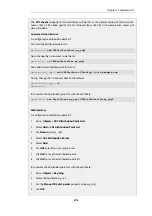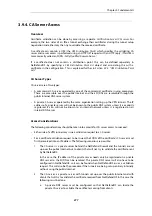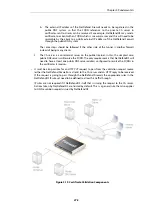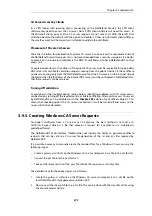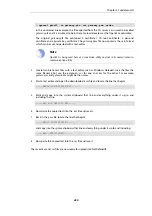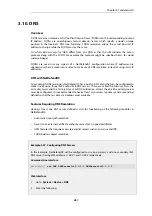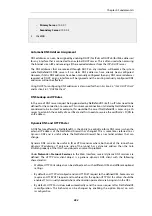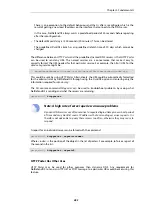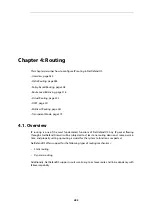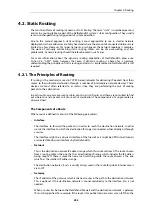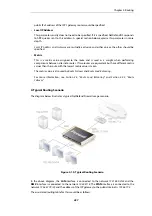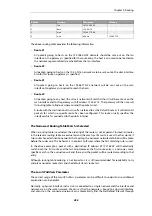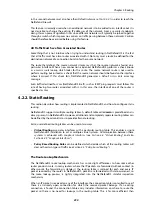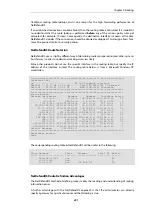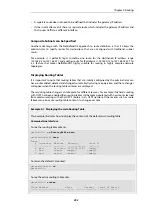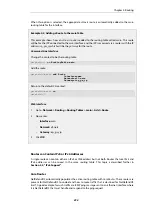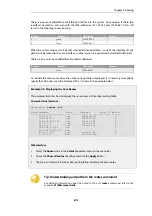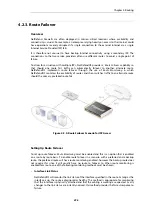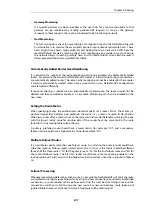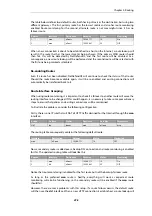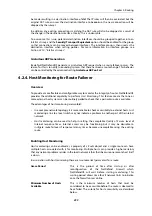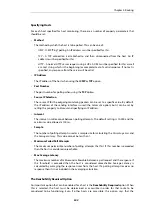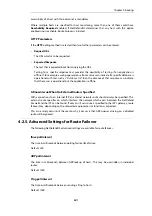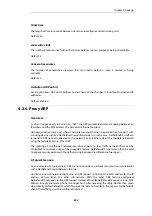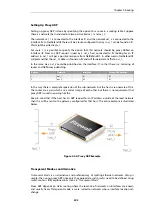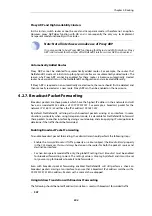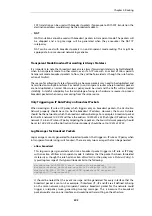
in this second network must also have their
Default Gateway
set to
10.2.2.1
in order to reach the
NetDefend Firewall.
This feature is normally used when an additional network is to be added to an interface but it is
not desirable to change the existing IP addresses of the network. From a security standpoint,
doing this can present significant risks since different networks will typically be joined together
through a switch which imposes no controls on traffic passing between those networks. Caution
should therefore be exercised before using this feature.
All Traffic Must have Two Associated Routes
Something that is not intuitive when trying to understand routing in NetDefendOS is the fact
that all traffic must have two routes associated with it. Not only must a route be defined for the
destination network of a connection but also for the source network.
The route that defines the source network simply says that the source network is found on a
particular interface. When a new connection is opened, NetDefendOS performs a check known
as a
reverse route lookup
which looks for this route. The source network route is not used to
perform routing but instead as a check that the source network should be found on the interface
where it arrived. If this check fails, NetDefendOS generates a
Default Access Rule
error log
message.
Even traffic destined for
Core
(NetDefendOS itself ), such as ICMP ping requests must follow this
rule of having two routes associated with it. In this case, the interface of one of the routes is
specified as
Core
.
4.2.2. Static Routing
This section describes how routing is implemented in NetDefendOS, and how to configure static
routing.
NetDefendOS supports multiple routing tables. A default table called main is predefined and is
always present in NetDefendOS. However, additional and completely separate routing tables can
be defined by the administrator to provide alternate routing.
Extra, user-defined routing tables can be used in two ways:
•
Virtual Routing associates interfaces with a particular routing table. This enables a single
NetDefendOS installation to act as multiple virtual systems. Communication between these
systems is achieved with
Loopback Interfaces
(see
Section 4.5, “Virtual Routing”
and also
Section 3.4.9, “Loopback Interfaces”
).
•
Policy Based Routing Rules can be defined which decide which of the routing tables will
deal with certain types of traffic (see
Section 4.3, “Policy-based Routing”
The Route Lookup Mechanism
The NetDefendOS route lookup mechanism has some slight differences to how some other
router products work. In many routers, where the IP packets are forwarded without context (in
other words, the forwarding is stateless), the routing table is scanned for each and every IP
packet received by the router. In NetDefendOS, packets are forwarded with state-awareness, so
the route lookup process is tightly integrated into the NetDefendOS stateful inspection
mechanism.
When an IP packet is received on any of the interfaces, the connection table is consulted to see if
there is an already open connection for which the received packet belongs. If an existing
connection is found, the connection table entry includes information on where to route the
packet so there is no need for lookups in the routing table. This is far more efficient than
Chapter 4: Routing
290
Summary of Contents for NetDefendOS
Page 30: ...Figure 1 3 Packet Flow Schematic Part III Chapter 1 NetDefendOS Overview 30 ...
Page 32: ...Chapter 1 NetDefendOS Overview 32 ...
Page 144: ...Chapter 2 Management and Maintenance 144 ...
Page 284: ...Chapter 3 Fundamentals 284 ...
Page 392: ...Chapter 4 Routing 392 ...
Page 419: ... Host 2001 DB8 1 MAC 00 90 12 13 14 15 5 Click OK Chapter 5 DHCP Services 419 ...
Page 420: ...Chapter 5 DHCP Services 420 ...
Page 573: ...Chapter 6 Security Mechanisms 573 ...
Page 607: ...Chapter 7 Address Translation 607 ...
Page 666: ...Chapter 8 User Authentication 666 ...
Page 775: ...Chapter 9 VPN 775 ...
Page 819: ...Chapter 10 Traffic Management 819 ...
Page 842: ...Chapter 11 High Availability 842 ...
Page 866: ...Default Enabled Chapter 13 Advanced Settings 866 ...
Page 879: ...Chapter 13 Advanced Settings 879 ...

